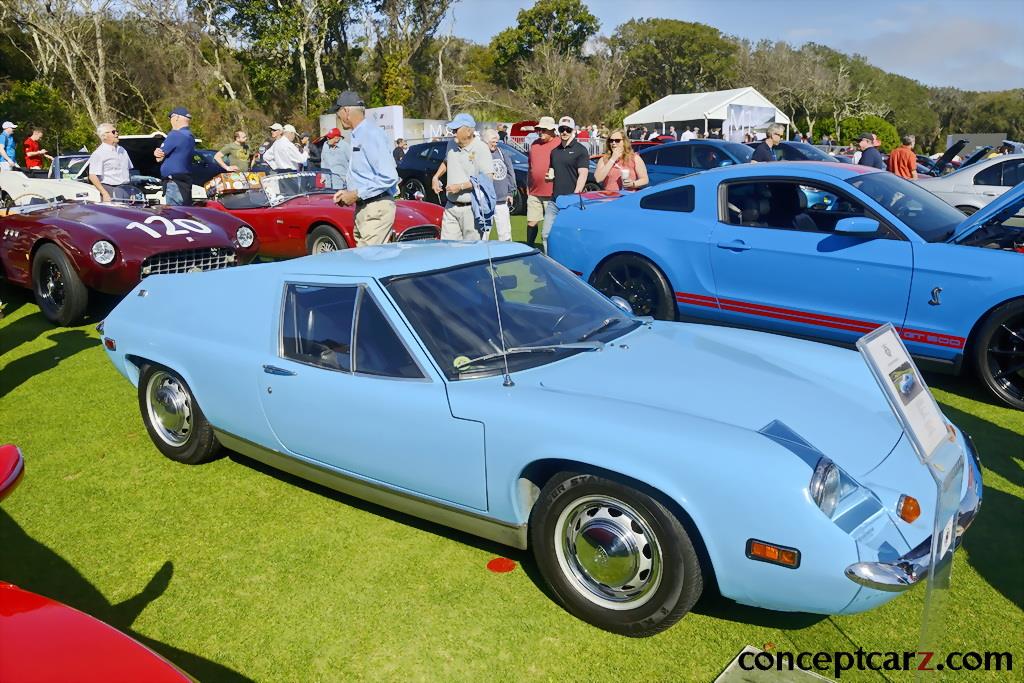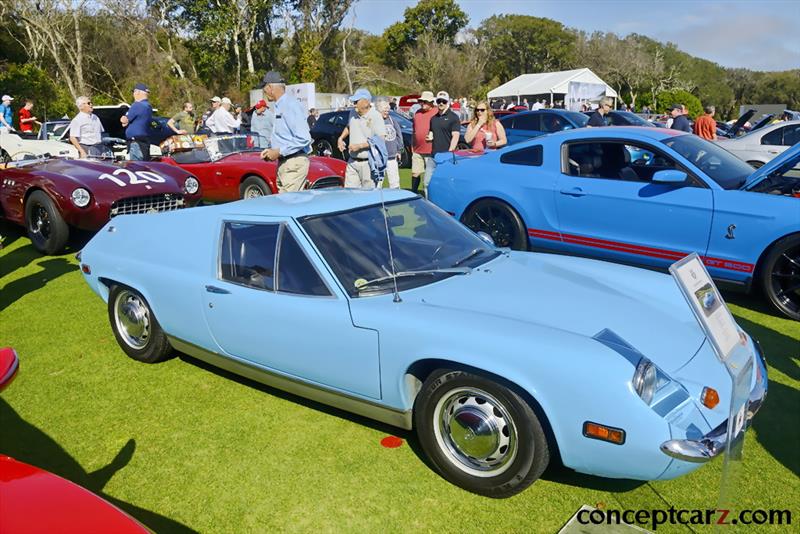The Lotus Europa was launched at the Brussels Show in 1967 and remained in production through 1975 with a total of 9,230 examples produced. The concept originated in 1963 with drawings by Ron Hickman, then director of Lotus Engineering. It was the marque's first mid-engined road car and was powered by a Renault 16 engine mounted in an Elan-type backbone frame. Specifications included disc brakes on the front wheels (subsequently on the rear, too) and all-round independent coil-sprung suspension. Unusual styling provided ample luggage space while rearward visibility through the narrow, full-width back window was rather good.The mid-engine revolution in motorsports was firmly established by the trim the Europa entered production, and it was among the first to use this configuration in road-going guise. Along with the novel mid-engine placement, it adhered to Colin Chapman's philosophy of 'Simplify, then add lightness.' Initially, its boxed-steel backbone chassis was clothed with a fiberglass moulded body that was both strong and lightweight. The wheelbase measured 92 inches, had a length of 160 inches, and stood just 42.5 inches tall. The main chassis members connected to the box-section cross-beam located between the front suspension points while the rear had a 'U' shaped beam located behind the cabin to accommodate the mechanical component load and support the rear suspension. The front suspension used lower wishbones with a coil-over spring-damper arrangement and upper pressed steel setup. In the back was a version of the Chapman strut with a tubular lower link, a box-section radius arm, and a fixed-length, articulated driveshaft top link. The steering gear was a rack and pinion sourced from the Triumph Herald. The 1,470cc Renault engine continued the light and modern theme with its block formed from aluminum and its cylinder liners from cast iron. It had a compact valve train thanks in-part to the overhead-valve design with the camshaft located high-up in the block. All of the ancillaries, including the alternator, belt drives, and water pump, were driven off a v-belt pulley fixed to the transaxle end of the camshaft. Unlike the Renault which had its transaxle positioned at the front of the engine and drove the front wheels, the Europa used a different setup, with the engine/transaxle unit relocated to the rear of the car and rotated 180 degrees. The result was a mid-engine configuration, albeit with four reverse gears. This shortcoming was resolved by repositioning the differential crownwheel within the final drive assembly, reversing the direction of rotation of the output shafts. The Renault engine in the Europa had its compression ratio raised from 8.6 to 1025, used larger inlet valves, twin-barrel carburetor, dual valve springs, and revised valve timings. Output rose by approximately twenty-three percent, from 63 to 82 horsepower at 6,000 RPM. Examples destined for the U.S.-market had a detuned 1,565cc engine with 80 horsepower at 6,000 RPM. During the production lifespan of the Europa, variants included the Types 46, 47, 54, 65 and 74. A total of 296 examples were S1 (chassis numbers from 460001 to 460296) and 342 were S1A/S1B. The Series 1A cars had removable side windows and internal door panel covers that could accommodate the windows once removed, and a wooden dashboard. The Series 1B had new rectangular light clusters and a redesigned rear panel. The Series 2 (from (approximately) chassis number 0645 forward) were far more popular with 4,294 examples built, followed by 4,950 examples of the Series Twin Cam. The Lotus Europa was manufactured exclusively for export for its first two years, making its U.K. debut in 1969 in improved S2 form. Since Volkswagen owned the rights to the Europa name in Germany, Lotus used the 'Europe' name for cars sold to that market. Renault engined like its S1 predecessor, the S2 reverted to a conventional body and chassis attachment, the S1 body shell was bonded in place which greatly simplified, and cheapened, accident repairs. Electric windows and adjustable seats were welcome additions to the previously minimalistic specification, as were the fully carpeted interior and polished wooden fascia panel for the dashboard. Due to United States regulations, only a small number of Series 2 Europa models were 'federalized' for export. Modifications made to comply with safety and emission regulations included low front fenders and the 1,565cc engine of the later Lotus Type 65. The Type 65, produced in 1969 and 1970, had additional modifications to the chassis, suspension, body, and powerplant, including a slightly modified Renault 16TL, 1565cc engine rated at 80 horsepower. The Type 74 Europa Twin Cam followed in the autumn of 1971 (mid-1971 in Europe and early 1972 in North America), and as its name suggests, was powered by the Ford-based DOHC engine from the Elan. Delivering slightly more than a hundred horsepower, the Twin Cam (twin-overhead camshaft, 8-valve) was capable of 117 mph, a figure bettered by the more powerful 'Big Valve' (126 horsepower) engined Special model that superseded it after a year.In September of 1972, Lotus introduced the Europa JPS Special in honor of Lotus's F1 World Championship title win in 1972 with John Player Special as the team's sponsor. These limited edition examples wore painted black with a gold pinstripe mimicking the livery of the Grand Prix cars, had a numbered JPS dashboard badge, Big Valve engine, and a five-speed gearbox. These were the first John Player Special commemorative Lotus production vehicles. A hundred examples were planned, but due to the popularity, of the 4,710 Type 74s produced, 3,130 were badged 'Specials.' While the first 100 had the JPS color scheme, the 'Specials' that followed could be purchased in colors other than black. The Lotus Europa succeeded in being a mid-engine, lightweight, road-going GT production car that was inexpensive, attractive, and sporty.
by Daniel Vaughan | Aug 2022
by Daniel Vaughan | Aug 2022
Similar Automakers
Similarly Sized Vehicles
from 1971
Similarly Priced Vehicles
1971 Lotus Europa Vehicle Profiles
Recent Vehicle Additions
Performance and Specification Comparison
Price Comparison
$4,895
Europa Series 2 Specification Comparison by Year
Year
Production
Wheelbase
Engine
Prices
Related Automotive News

World-premiere: All-new 2015 Alfa Romeo 4C Spider Delivers Race-inspired Performance, Advanced Technologies, Seductive Italian Style, and now an Even More Exhilarating Driving Experience With Open-air Freedom
Production version of the all-new 2015 Alfa Romeo 4C Spider, revealed at the 2015 North American International Auto Show, will arrive at dealerships this summer All-new 2015 Alfa Romeo 4C Spiders open-air performance cockpit and mid-engine propo...

CHEVROLET TO SHOW CHAPARRAL VISION GRAN TURISMO CONCEPT
Boundary-pushing, Chevy-powered race cars changed motorsports design
DETROIT – When racers Jim Hall and Hap Sharp founded Chaparral Cars in 1962, few could have guessed how they would shake up the conformities of the racing world – and...

All-new Alfa Romeo 4C Debuts at the 2014 New York Auto Show, Marks the Iconic Italian Brand's Return to North America
2014 New York Auto Show debut of all-new 2015 Alfa Romeo 4C coupe and limited-edition 4C Launch Edition marks the Italian sports car brands return to the North American market
Mid-engine proportions and inspiration from the brands racing traditio...

1964 Nurburgring 1000 Kilometers: Survive for One Last Victory
During the late 1950s, Richie Ginther would begin a relationship with John von Neumann and this partnership would result in one of the most dominant periods of American sportscar racing in which Ginther and Porsche would be virtually unbeatable. Nearly...

MIKE RYAN'S BANKS SUPER-TURBO PIKES PEAK FREIGHTLINER A UNIQUE BIG ONE TO WATCH IN PIKES PEAK OPEN DIVISION
Colorado Springs, June 20--------The Freightliner Cascadia Pikes Peak Special racing machine of Mike Ryan (Santa Clara, CA) is truly like no other entry in the Pikes Peak Open division during the 91st edition of the Pikes Peak International Hill...









